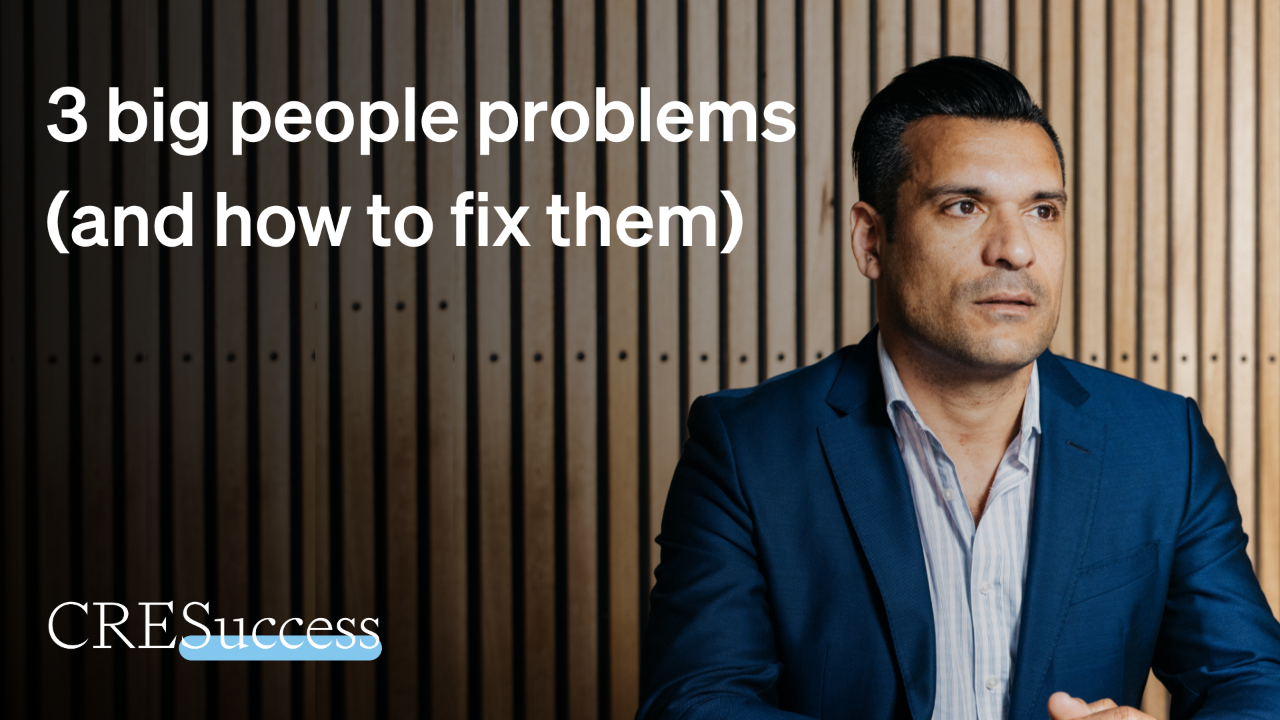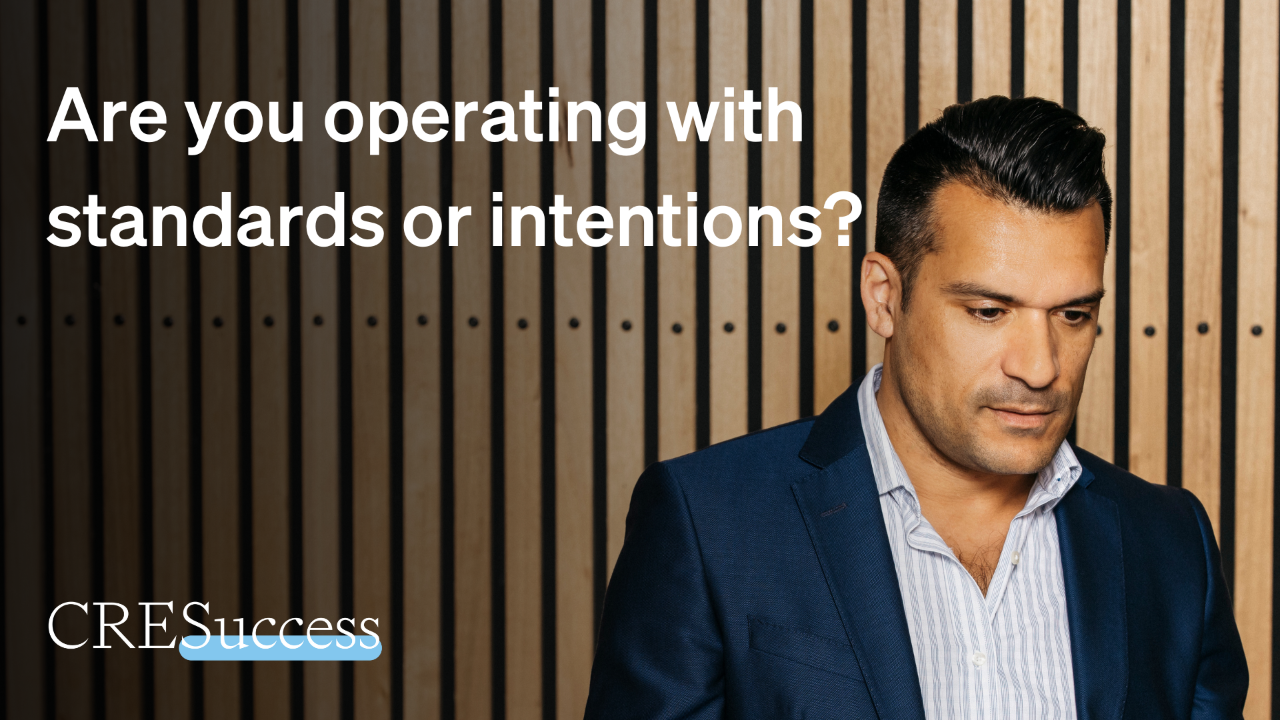How to handle people problems as a commercial real estate principal.
Oct 08, 2025
CRE Success Principle: A high performer with a poor attitude may deliver revenue, but they’re killing morale. No deal or individual should ever be bigger than the values you believe in.
When I talk to commercial real estate principals, the biggest challenges they face are usually about their people. Clients, deals and systems matter, but people are the most common source of stress.
Here are three not-too-uncommon scenarios:
- Two team members who just can’t get along
- A high performer who undermines culture with a poor attitude
- A lack of boundaries that makes the leader a bottleneck in the business
Conflict should never be ignored. It doesn’t make you a bad leader if conflict arises, but how you deal with it shows the quality of your leadership.
Listening first, clarifying roles, setting standards, and following up consistently are the keys to resolving disputes.
With high performers who display toxic behaviors, the message is simple: no individual deal or revenue contribution is more important than culture.
Address the issue directly, link it back to values, and set clear expectations for change.
Finally, boundaries matter. Being accessible is good leadership, but being available for everything turns you into the bottleneck.
Encourage your team to step up and take ownership so the business can grow without everything falling back on you.
If you want to hear more about how to handle these common people problems, check out episode 241 of Commercial Real Estate Leadership.
Episode transcript:
If you've ever dealt with two team members who just can't get along, or maybe a high performer who's got a bit of a bad attitude, you're not alone.
It's problems that I've dealt with talking to my private clients recently.
So, I thought I would talk about those common people issues in this episode, because being a good or a great commercial real estate principal really comes down to how you lead and deal with your people.
And when conflict, underperformance, or perhaps lack of boundaries shows up in your business, it's a test of your leadership.
So, I want to show you how you can pass the test with flying colors in this episode.
This is episode 241 of Commercial Real Estate Leadership. My name's Darren Krakowiak. I help commercial real estate principals lead their people to better performance, grow revenue in their business faster, and have less stress in their lives.
And one of the biggest sources of stress for commercial real estate principals is people.
The majority of challenges that my private clients have is in relation to people.
I was speaking to somebody recently who told me that the way they come up with content for their podcast is to review their recent notes of what they're dealing with with their clients and just talk about how they help their clients with those common problems. And I thought, well, that is a great idea.
I had a look through my notes from August, and I could see that there were some common people management issues that were coming up. So I thought that would be a great topic to talk about in today's episode.
I want to frame this by saying that addressing conflict head on is the point.
When you avoid conflict, it leads to resentment for the people who don’t appreciate the conflict that's going on, including people on the sidelines. It can lead to disengagement and employee turnover.
And when there is conflict, bad behavior, or when people aren't acting in accordance with the values you’ve established for the business, that kills the culture you want to protect and grow.
Now, I want you to know that when conflict does occur, it's not necessarily your fault. So don't feel like you're a failure as a leader when there is conflict, poor performance, or poor behaviors.
The point is: when you see this behavior, it's about how you respond. It's about how you handle it, and that is the reflection of you as a leader.
You're not a bad leader because there is conflict or there’s issues. You're just a good one if you know how to handle them, and if you don’t avoid them.
Addressing these issues does take energy, and I get that. But ignoring these issues just is going to cost you more in the long run. It's the classic case of a stitch in time saves nine.
Because ignoring these issues doesn't make them go away. It sends the message that bad behavior is tolerated, and it creates a bigger problem for you to deal with in the future.
So, let's talk about three issues or scenarios.
I’ll change the circumstances a little bit to protect the guilty.
And I hope that some of the advice that I give my clients might be helpful to you as well.
So, the first scenario I want to talk to you about is when you've got two team members who just can't get along.
There’s ongoing conflict. It might be a clash of personalities, a breakdown in communication, or misaligned expectations.
That tension is affecting morale, not only of those two warring parties, but also people around them. It’s dragging down productivity.
I recommended to a client who was dealing with this recently, a bit of a framework for how to address conflict both individually with the two parties, one by one, and then also to bring them together.
So, let's talk about the conversation with the individuals.
You might know deep down who the real problem is and who's more at fault, but the first step is to listen and gather the facts. Resist the urge to pick a side.
Your job is to resolve the tension, not to escalate it by making someone feel like they're guilty before proven to be.
So, listen by looking to understand all sides without judgment.
And also, ask open questions that really show that you are open to understanding the issue as opposed to leading questions and practice active listening and listen in entirety to what people have to say.
After you’ve listened, I think then we want to clarify roles. Conflict often arises from unclear expectations.
Just remind people of who's responsible for what their roles and responsibilities, the lines of demarcation for who should be doing what. And sometimes that can provide clarity in terms of what people should be doing and what they are responsible for.
Another thing to do after you've listened and clarified roles, is to talk about standards.
So, setting standards, defining what good communication and collaboration looks like.
I like the frame of optimal and suboptimal behavior. When you're behaving sub optimally, you are behaving in a way which isn't as good as you could be in that circumstance and as much as possible when it be above that optimal line and being optimal rather than suboptimal.
And you can also link it back to company values. And this is why having a stated set of values is important because you can tie back the behaviors that you're looking for to reflect the values that you've set for the business.
And that can be tied to the expectations that you have for the way that people act and the way that they perform in the business.
So, you've listened, you've clarified roles, you've set standards, and finally, you've got a follow up. Don’t assume the problem is solved after one conversation. Track progress and hold people accountable.
So, the key here is to be consistent and transparent. You're not expected to solve the problem immediately, but if you're very clear on your communications, I think the problem is likely to be resolved sooner.
So that's how you can have a conversation with one person. You may also decide, if appropriate, to bring two individuals together.
I would speak to them both separately first, and if you think that it can be resolved more quickly by bringing people together to identify what is the commonality, what are the shared goals, and to set some foundations for what optimal behavior and mutual trust look like, have a conversation and ask questions like, what do you need from each other to work together effectively?
Where do you feel like you're not on the same page and how can we close that gap?
Again, often the issue isn't personal. It's unclear expectations or miscommunication.
So, we want to make sure people understand what you're looking for in terms of collaboration, how they communicate, when issues are escalated, and how they're expected to support each other as co-workers.
And remind them, we're not looking for everyone here to be best friends.
Best friends—my daughter is in kindergarten, and one of the sledges that kindergarten kids use, like the nasty thing they say to each other is: “You're not my best friend.”
But in a work scenario, that's OK. We don't have to be best friends. We're here to deliver results, and what we need to do is just be respectful and professional in terms of how we communicate and behave with each other.
And if you're able to resolve this conflict, you're not just fixing a problem, what you're doing is you're modeling leadership and you're reinforcing the culture and the values for the whole team.
So that's the scenario of dealing with two warring employees and how you might like to resolve that.
The next scenario that was coming up when I was reviewing these notes was the high performer with a poor attitude.
This is when someone's delivering great results, the revenue's looking good, they're doing deals, the output's great, but they're a little bit toxic, right?
In meetings, they're dismissive of others, they undermine other people, they're difficult to manage, they're not a team player.
So, you've got to have a conversation with this person when you see that.
The first thing to do, I think, is to acknowledge their performance and let them know that they're doing all of this great stuff, but also address the behavior that you're not particularly appreciating.
And that's as simple as saying, “You're delivering at a high level, and we value that, but the way that you show up matters as well.”
No one person, no deal, no amount of revenue is more important than the culture, than the values that we have as a business.
And I think often high performers don't understand the impact, the external ripple effect that they have on others.
So, I think we've got to tell them. Tell them how their behavior is impacting others, how it's threatening the culture that you've taken so long to build, and let them know that we're not going to tolerate that type of bad behavior even from high performers.
Because it comes at the cost of the cohesion for the team, and it doesn't make your job enjoyable as well.
And again, tie it back to your values. If you've set values in the business, whether that's collaboration or respect or reliability, state that as a value and then say, when you do this or that, then you're not acting in accordance with our values.
You can offer them support, help, set the standard that they're expected to adhere to, and also provide a timeline for them to change by and set consequences if that change doesn't occur.
Because sometimes protecting the culture means having tough conversations with top performers, because the standard you walk by is the standard you accept.
Sometimes top performers think they're exempt. Or I've heard some people say, “Oh, well, what we want to do is sort of quarantine this person, and we can somehow just limit the amount of contact that they have with everyone else in the business, and then we can limit the fallout from how toxic they are.”
But I don't think that works, and I don't think that's appropriate. You've got to address the issue head on, and if they're not able to act in a way which is in accordance with their values, then you've got to find a way to replace that revenue by employing someone who is, because again, no one person should be bigger than the culture that you're looking to create and protect inside your business.
The third scenario that I've been helping a client with recently is lack of boundaries.
This particular client loves being approachable, loves helping their team, loves being available, quite responsive with replies, happy to provide that reassurance, happy to resolve issues on behalf of their team.
But that, and again, this is sort of like our last episode where we talked about you should execute or escalate, creates a bottleneck in the business.
And when this is happening, when people are relying on you too much, it's not their fault. It's in response to the way that you've been training them to behave, right?
Being a supportive leader doesn't mean that you do everything for everyone else or say YES all the time.
You're slowing them down by forcing them to come to you and you're limiting the results that the business can achieve by making yourself the bottleneck, right?
So, as we talked about in the episode last week, we want to find ways for people to take ownership of problems by deciding when they can own an issue, when input is needed, when approval is required, and reminding them that they often have the right answers.
So, when they are coming to you with questions, just say, “Well, what do you think would be the right answer?”
And if you can see that they've got the answers, then you can give them license to start to execute without having to come to you with every little problem.
So yes, be accessible, be available, provide support, but don't be a bottleneck.
Set boundaries so your team can step up. And if you are also, in this particular case, there was communication outside of normal business hours, I think we want to let people know what rises to the level of an issue which would justify a text on, let's say, a Sunday evening.
So, look, when you've got any of these issues—and you know these are clients, people who are working with me—problems still come up, right?
It doesn't mean you're a failure. It doesn't mean you're a bad leader. It's just a signal, it's an opportunity for you to be a great leader by responding and acting in a way which can protect, preserve, and grow the culture that you've spent so long trying to build.
So maybe one of those three stories had some resonance or relevance for you. I'd love to hear from you about what's the biggest people challenge that you've faced in your business.
You can send me a message on LinkedIn or you can DM us on Instagram @cresuccess
Let me know how you've resolved it, or maybe you're dealing with a challenge currently.
And one of the insights that we've shared in this episode might be a bit of help for you to deal with that issue. I'd love to hear about that as well.
That is our episode for today. Thank you so much for listening, and I will speak to you soon.








